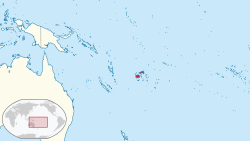| Fiji white-eye | |
|---|---|
 | |
| In forest at De Voeux Peak on Taveuni | |
| Scientific classification | |
| Kingdom: | Animalia |
| Phylum: | Chordata |
| Class: | Aves |
| Order: | Passeriformes |
| Family: | Zosteropidae |
| Genus: | Zosterops |
| Species: | Z. explorator |
| Binomial name | |
| Zosterops explorator Layard, 1875 | |
 | |
| Range highlighted in red | |
The Fiji white-eye (Zosterops explorator) is a species of passerine bird in the white-eye family Zosteropidae. The species is also known as Layard's white-eye. [2]

It is endemic to the islands of Viti Levu, Vanua Levu, Taveuni, Kadavu, and Ovalau in Fiji, where it is a common bird of forests. [3] Where it co-occurs with the closely related silvereye it is more common in denser forest.
It is a typical small white-eye of the genus Zosterops, similar in appearance to the silvereye, although the plumage is much yellower, it is chunkier and has a complete eye-ring. [3] The back is olive green and the throat and belly yellow. The call is described as "a high pitched seeu-seeu".
The Fiji white-eye feeds by gleaning insects from shrubs and trees. It will join mixed-species feeding flocks with other Fijian birds, including silvereyes. It also feeds lower down in the trees than silvereyes. [4]
